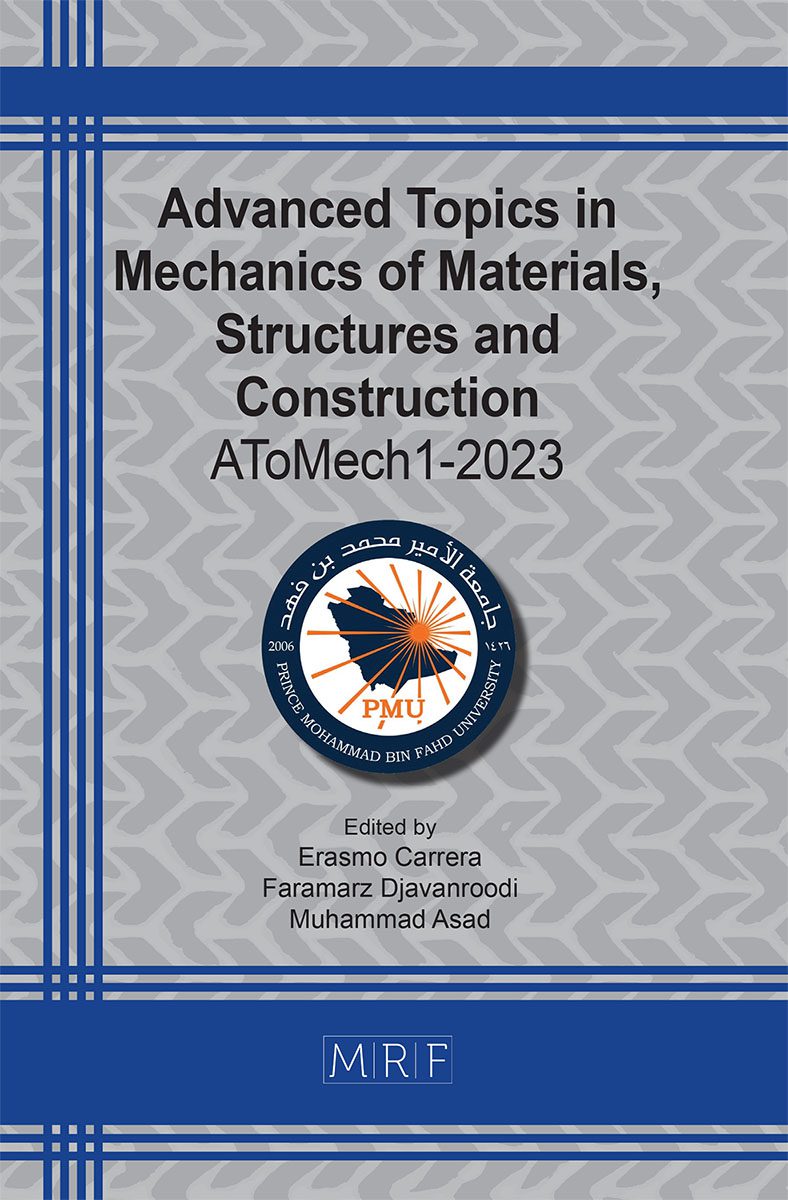Constitutive modeling of dynamic strain aging in niobium
Modified VA Model, Dynamic Strain Aging, Thermal Activation Energy, Niobium
download PDFAbstract. As the temperature rises, metals should lose strength. However, under some combinations of strain rate and temperature, they show a dramatic increase in strength due to the interaction of impurity/solute atoms with the dislocations, a phenomenon known as dynamic strain aging (DSA). Thermomechanical stress-strain curves have been modeled using a variety of numerical approaches, but accurately modeling DSA activation remains a challenge. The activation free energy for dislocation movement rises during DSA, as there are more solute atoms concentrated at the local barriers. As a result, we see an increase in strength. This work modifies the physical parameters-based VA model for commercially pure bcc Niobium, which is known to display DSA at low strain rates and elevated temperatures, in order to create a constitutive model that can accurately capture DSA.
Keywords
Modified VA Model, Dynamic Strain Aging, Thermal Activation Energy, Niobium
Published online 8/10/2023, 7 pages
Copyright © 2023 by the author(s)
Published under license by Materials Research Forum LLC., Millersville PA, USA
Citation: Modified VA Model, Dynamic Strain Aging, Thermal Activation Energy, Niobium, Constitutive modeling of dynamic strain aging in niobium, Materials Research Proceedings, Vol. 31, pp 128-134, 2023
DOI: https://doi.org/10.21741/9781644902592-14
The article was published as article 14 of the book Advanced Topics in Mechanics of Materials, Structures and Construction
![]() Content from this work may be used under the terms of the Creative Commons Attribution 3.0 license. Any further distribution of this work must maintain attribution to the author(s) and the title of the work, journal citation and DOI.
Content from this work may be used under the terms of the Creative Commons Attribution 3.0 license. Any further distribution of this work must maintain attribution to the author(s) and the title of the work, journal citation and DOI.
References
[1] Johnson, G.R. and W.H. Cook, Fracture characteristics of three metals subjected to various strains, strain rates, temperatures and pressures. Engineering fracture mechanics, 1985. 21(1): p. 31-48. https://doi.org/10.1016/0013-7944(85)90052-9
[2] Zerilli, F.J. and R.W. Armstrong, Dislocation‐mechanics‐based constitutive relations for material dynamics calculations. Journal of applied physics, 1987. 61(5): p. 1816-1825. https://doi.org/10.1063/1.338024
[3] Nemat-Nasser, S. and J. Isaacs, Direct measurement of isothermal flow stress of metals at elevated temperatures and high strain rates with application to Ta and TaW alloys. Acta Materialia, 1997. 45(3): p. 907-919. https://doi.org/10.1016/S1359-6454(96)00243-1
[4] Voyiadjis, G.Z. and F.H. Abed, Effect of dislocation density evolution on the thermomechanical response of metals with different crystal structures at low and high strain rates and temperatures. Archives of Mechanics, 2005. 57(4): p. 299-343.
[5] Van den Beukel, A., Theory of the effect of dynamic strain aging on mechanical properties. Physica status solidi (a), 1975. 30(1): p. 197-206. https://doi.org/10.1002/pssa.2210300120
[6] Ghazisaeidi, M., L. Hector Jr, and W. Curtin, Solute strengthening of twinning dislocations in Mg alloys. Acta materialia, 2014. 80: p. 278-287. https://doi.org/10.1016/j.actamat.2014.07.045
[7] Mulford, R. and U. Kocks, New observations on the mechanisms of dynamic strain aging and of jerky flow. Acta Metallurgica, 1979. 27(7): p. 1125-1134. https://doi.org/10.1016/0001-6160(79)90130-5
[8] Abed, F., A. Abdul-Latif, and G.Z. Voyiadjis, Performance of MMFX steel rebar at elevated temperatures. Journal of Engineering Mechanics, 2020. 146(11): p. 04020126. https://doi.org/10.1061/(ASCE)EM.1943-7889.0001862
[9] Abed, F.H. and G. Voyiadjis, Adiabatic shear band localizations in BCC metals at high strain rates and various initial temperatures. International Journal for Multiscale Computational Engineering, 2007. 5(3-4). https://doi.org/10.1615/IntJMultCompEng.v5.i3-4.120
[10] Voyiadjis, G. and F. Abed, Transient localizations in metals using microstructure-based yield surfaces. Modelling and Simulation in Materials Science and Engineering, 2006. 15(1): p. S83. https://doi.org/10.1088/0965-0393/15/1/S08
[11] Moris Devotta, A., et al., A modified Johnson-Cook model for ferritic-pearlitic steel in dynamic strain aging regime. Metals, 2019. 9(5): p. 528. https://doi.org/10.3390/met9050528
[12] Cheng, J. and S. Nemat-Nasser, A model for experimentally-observed high-strain-rate dynamic strain aging in titanium. Acta materialia, 2000. 48(12): p. 3131-3144. https://doi.org/10.1016/S1359-6454(00)00124-5
[13] Abed, F.H., et al., Flow stress and damage behavior of C45 steel over a range of temperatures and loading rates. Journal of Engineering Materials and Technology, 2017. 139(2). https://doi.org/10.1115/1.4035488
[14] Nemat-Nasser, S. and W. Guo, Flow stress of commercially pure niobium over a broad range of temperatures and strain rates. Materials Science and Engineering: A, 2000. 284(1-2): p. 202-210. https://doi.org/10.1016/S0921-5093(00)00740-1
[15] Abed, F.H. and G.Z. Voyiadjis, Plastic deformation modeling of AL-6XN stainless steel at low and high strain rates and temperatures using a combination of bcc and fcc mechanisms of metals. International Journal of Plasticity, 2005. 21(8): p. 1618-1639. https://doi.org/10.1016/j.ijplas.2004.11.003
[16] Voyiadjis, G.Z. and F.H. Abed, Microstructural based models for bcc and fcc metals with temperature and strain rate dependency. Mechanics of Materials, 2005. 37(2-3): p. 355-378. https://doi.org/10.1016/j.mechmat.2004.02.003
[17] Abdul-Latif, A., et al., Effect of various temperatures and strain-rates combinations on the thermomechanical behavior of 42CrMo steel. Archives of Mechanics, 2022. 74(5).
[18] Abed, F.H., S.I. Ranganathan, and M.A. Serry, Constitutive modeling of nitrogen-alloyed austenitic stainless steel at low and high strain rates and temperatures. Mechanics of Materials, 2014. 77: p. 142-157. https://doi.org/10.1016/j.mechmat.2014.07.007































